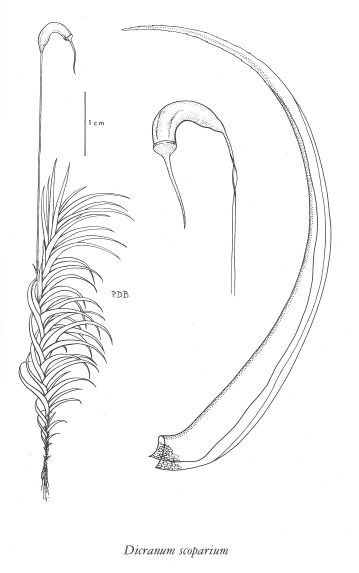Dicranum scoparium Hedw.
broom-moss (dicranum moss)
Dicranaceae
Species Account Author: Wilf Schofield
Extracted from Some Common Mosses of BC
Introduction to the Bryophytes of BC
broom-moss (dicranum moss)
Dicranaceae
Species Account Author: Wilf Schofield
Extracted from Some Common Mosses of BC
Introduction to the Bryophytes of BC
Species Information
Species description:
Species name refers to a broom, from the swept appearance of the leaves on the stem.
Comments:
Sometimes called "stork's bill moss" in reference to the strongly snouted operculum, or "broom moss" based on the frequently curved swept-to-one-side appearance of the leaves.
Distinguishing characteristics:
This is an extremely variable species with considerable habitat diversity; therefore, it is readily confused with several other species of Dicranum. The most useful features include the non-undulate, usually curved leaves (except in drier open nutrient-poor sites), the usual lack of abundant matting of rhizoids, and the occurrence of single sporophytes on each shoot.
Habit:
Forming loose to dense, tall turfs of glossy, pale to dark green, generally unbranched or irregularly branched plants that show considerable variability in leaf orientation.
Similar Species:
From D. majus, D. scoparium is readily distinguished on the basis of the multiple sporophytes in the former. When vegetative, these species are difficult to separate, even on microscopic characters. From species of Campylopus and Paraleucobryum the very broad midrib in these two genera will separate D. scoparium with its narrower midrib. In these genera the midrib occupies 1/3, or more of the leaf width.
Illustration

If more than one illustration is available for a species (e.g., separate illustrations were provided for two subspecies) then links to the separate images will be provided below. Note that individual subspecies or varietal illustrations are not always available.
Illustration Source: Some Common Mosses of BC
Habitat and Range
Habitat
On rotten logs, exposed cliff edges, sometimes on forest floor and tree trunks, from sea level to subalpine and alpine elevations; predominantly in forest but also in open sunny sites. Range
World DistributionCircumpolar in the Northern Hemisphere; also in New Zealand. In North America southward in the east to Florida and Arkansas and in the west to California and Arizona.